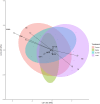In ovo feeding of methionine affects antioxidant status and growth-related gene expression of TETRA SL and Hungarian indigenous chicks
- PMID: 38388769
- PMCID: PMC10884004
- DOI: 10.1038/s41598-024-54891-3
In ovo feeding of methionine affects antioxidant status and growth-related gene expression of TETRA SL and Hungarian indigenous chicks
Abstract
Methionine (Met) plays a substantial role in poultry due to its involvement in several pathways, including enhancing antioxidant status and improving growth performance and health status. This study examined how in ovo feeding of Met affects hatching performance, antioxidant status, and hepatic gene expression related to growth and immunity in the TETRA-SL LL hybrid (TSL) commercial layer and Hungarian partridge colored hen (HPC) indigenous genotypes. The eggs were injected with saline, DL-Met, and L-Met on 17.5 days of embryonic development. The results showed that the in ovo feeding of DL-Met significantly increased the hatching weight and ferric reducing the ability of the plasma (FRAP) compared with L-Met. The in ovo feeding of either Met source enhanced the liver health and function and hepatic antioxidant status of the chicks. The genotype's differences were significant; the TSL genotype had better hatching weight, an antioxidant defense system, and downregulated growth-related gene expression than the HPC genotype. In ovo feeding of either Met source enhanced the chicks' health status and antioxidant status, and DL-Met improved the hatching weight of the chicks more than L-Met. Genotype differences were significantly evident in the responses of growth performance, antioxidant status, blood biochemical parameters, and gene expression to Met sources.
© 2024. The Author(s).
Conflict of interest statement
The authors declare no competing interests.
Figures





Similar articles
-
Methionine sources and genotype affect embryonic intestinal development, antioxidants, tight junctions, and growth-related gene expression in chickens.Anim Nutr. 2023 Dec 1;16:218-230. doi: 10.1016/j.aninu.2023.11.005. eCollection 2024 Mar. Anim Nutr. 2023. PMID: 38362512 Free PMC article.
-
Effects of in ovo feeding of disaccharide and/or methionine on hatchability, growth performance, blood hematology, and serum antioxidant parameters in geese.J Anim Sci. 2022 Feb 1;100(2):skac014. doi: 10.1093/jas/skac014. J Anim Sci. 2022. PMID: 35094079 Free PMC article.
-
Effects of DL and L-Methionine on Growth Rate, Feather Growth, and Hematological Parameters of Tetra-SL Layers from 1-28 Days of Age.Animals (Basel). 2022 Jul 28;12(15):1928. doi: 10.3390/ani12151928. Animals (Basel). 2022. PMID: 35953916 Free PMC article.
-
Effect of in ovo injection of DL-methionine on hatchability, embryo mortality, hatching weight, blood biochemical parameters and gastrointestinal tract development of breeder chicks.Anim Biotechnol. 2023 Dec;34(8):3671-3680. doi: 10.1080/10495398.2023.2199501. Epub 2023 Apr 13. Anim Biotechnol. 2023. PMID: 37051917
-
Systematic review and meta-analysis of the methionine utilization efficiency in piglets receiving different methionine sources.Animal. 2023 Dec;17 Suppl 5:100894. doi: 10.1016/j.animal.2023.100894. Epub 2023 Jun 26. Animal. 2023. PMID: 37482458
Cited by
-
Effect of in ovo-fed amino acids on muscle and liver metabolome of broiler chickens at 24 h post-hatch.Front Physiol. 2025 Apr 25;16:1542426. doi: 10.3389/fphys.2025.1542426. eCollection 2025. Front Physiol. 2025. PMID: 40352141 Free PMC article.
-
Plant-Scale Circular Economy Using Biological Reuse of Electrolyte Residues in the Amino Acid Industry.Bioengineering (Basel). 2024 Dec 30;12(1):24. doi: 10.3390/bioengineering12010024. Bioengineering (Basel). 2024. PMID: 39851298 Free PMC article.
-
Effects of early feeding technologies providing methionine supplementation on performance, lipid oxidation, and some immune-related gene expression in broiler chicken.Poult Sci. 2025 Aug;104(8):105335. doi: 10.1016/j.psj.2025.105335. Epub 2025 May 26. Poult Sci. 2025. PMID: 40449108 Free PMC article.
-
Embryonic Leucine Promotes Early Postnatal Growth via mTOR Signalling in Japanese Quails.Animals (Basel). 2024 Sep 6;14(17):2596. doi: 10.3390/ani14172596. Animals (Basel). 2024. PMID: 39272381 Free PMC article.
References
-
- Elwan H, et al. Effects of In ovo methionine-cysteine injection on embryonic development, antioxidant status, IGF-I and TLR4 gene expression, and jejunum histomorphometry in newly hatched broiler chicks exposed to heat stress during incubation. Animals. 2019;9:25. doi: 10.3390/ani9010025. - DOI - PMC - PubMed
-
- Lugata JK, et al. Effect of genotype on the hematological parameter of TETRA-SL and Hungarian Partridge coloured chickens at young age. Acta Agrar. Debreceniensis. 2022;2022:99–104. doi: 10.34101/actaagrar/1/10395. - DOI
MeSH terms
Substances
Grants and funding
LinkOut - more resources
Full Text Sources
Medical
Miscellaneous

